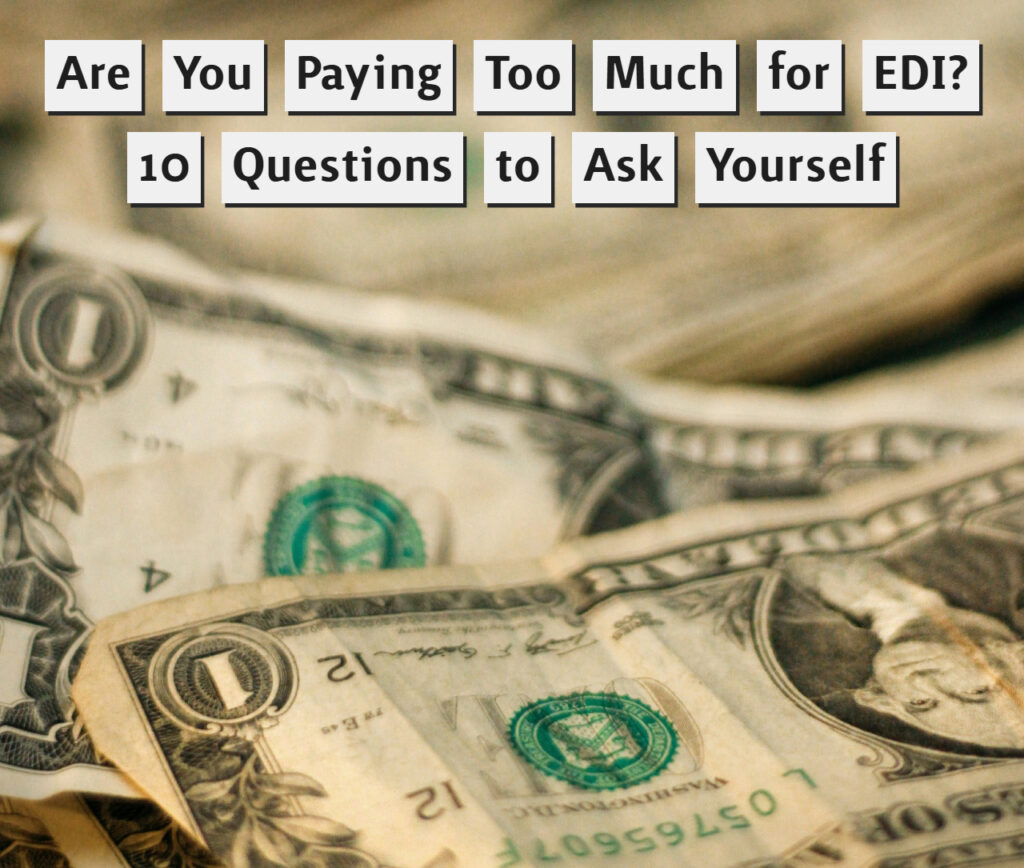
If there’s one constant in the business world, it’s the struggle to get the most bang for each buck you invest into your company. And while technology is a requirement to get ahead in today’s competitive environment, it can be difficult to demonstrate that bang-for-buck equation.
Complicating the matter is the fact that EDI pricing is often murky and hard to decipher. If you’re having trouble figuring out whether your return on EDI investment is where it should be, you’re not alone.
That’s why we’ve put together this list of questions to ask about your current EDI solution so you can ensure your business gets the value your provider promised.
1. Are you paying more than $1 per document?
If you divide your total monthly EDI cost by the number of documents processed and get more than $1 per document, you’re wasting a truckload of money. Here at Better EDI, we spoke to one customer who saved $26.50 per document by moving to a new provider.
2. Are you paying more than $1000 for fewer than 5 trading partners?
There’s no reason to pay a steep fee for so few trading partners and a relatively simple data stream. A reasonable rate is $100 per partner – so if you have 5 partners, your total fee should be $500, not $1000.
3. Are you paying the same fee all year, even during slow months?
Most businesses have both slow and busy seasons. It makes sense to pay for higher EDI transaction volume during, say, the Black Friday to Christmas period. But if you’re paying that same amount in months when business is slow, you may be just burning money.
4. Are you paying high monthly fees during a never-ending implementation process?
Many big EDI providers share two big issues: they’re built on antiquated technology and they have huge customer lists. It’s far too easy for your implementation to fall behind as your big provider focuses on the noisier, more demanding customers.
If you’re paying a premium for an EDI solution but you can’t use it for months on end, it’s time to have a pointed conversation with your provider.
5. Are you paying for a full EDI solution that’s only half implemented?
Investing in a huge solution with too many bells and whistles for what you actually need it to do is another big source of potential waste.
6. Did you sign up for an integrated service, only to still be doing a lot of manual work?
Remember that antiquated technology we mentioned earlier? It leads to another big problem: reduced productivity. If you’re paying a premium for “integrated” EDI but you still have to manually transfer data to and from some systems, what are you really paying for?
7. Are you paying multiple EDI companies for multiple EDI platforms?
With an EDI solution that can’t properly integrate with all of your trading partners, you may end up with several different EDI platforms required to handle all of your different data streams. This not only adds complexity to your operation, but also results in more wasted money.
It may seem like you need separate, specific EDI services for different partner needs, but that’s not the case.
8. Are you getting pummeled by overage fees?
With many providers still working on long-distance phone plans, exceeding your contracted tier’s volume saddles you with extra charges. Signing up for a yearly document plan that doesn’t include overage alerts leads to ballooning costs. And if you have a particularly big month, those charges can put a major dent in that month’s profits. You’re essentially being penalized for growing your business on this model.
9. Do you pay by the line or kilocharacter for all of your documents?
Back in the early EDI days, data transfer was a lot more expensive and volumes were much smaller, so it made sense to charge by the kilocharacter.
The problem is, a lot of EDI providers still use that pricing model today – and it makes a lot less sense now that broadband is widespread. And if your purchase orders are all different lengths, this pricing gets really confusing, really fast.
10. Do you have to deal with a new work order or change order every time you add a new trading partner or need a mapping change?
If so, and you’re in a fast growth phase, you’re going to have a lot of frustration and extra costs.
Did you answer “Yes” to too many of these questions?
If so, it’s time for a change. Modern EDI providers should be able to give you clear, easy to understand pricing without charging you for a lot of extra nonsense. Check out Better EDI’s pricing if you want an example – and if you’re ready to make a change, we’re here to help.
